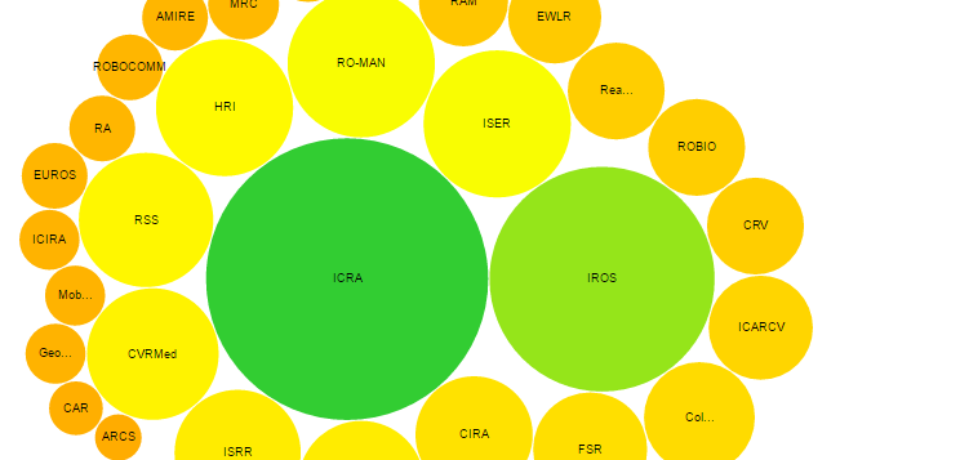Oct 8, 2016 @ 21:34 |
The year 1988 is considered as birth year of IROS and IROS 2016 is the 29th conference in the series. IROS is an annual IEEE/RSJ International conference covering latest advancements in fast growing field of robotics
The second week of October 2016 is full of excitement for robotics community due to two major robotic conferences – IROS (IEEE/RSJ International Conference on Intelligent Robots and Systems) and ROSCon 2016. And by luck both the conferences happening in Seoul, South Korea back to back so get double benefit to meet robotics experts in single visit. Here RobotGlobe brought to you 5 points about IROS that you should know:
1. Glorious History of IROS
The year 1988 is considered as birth year of IROS and IROS 2016 is the 29th conference in the series. Established in 1988, IROS is an annual IEEE/RSJ International conference covering latest advancements in fast growing field of robotics. IROS brings together an international community of researchers, educators and practitioners to explore the frontier of science and technology in intelligent robots and systems.

In the first 10 year (1988 to 1998) IROS was publishing around 300 papers with acceptance rate around 80 to 90 percent. But in 21st century Attendance of IROS increased very rapidly. For instance, the number of paper in 1996 was less than 400 but nearly four time in 2005 and there was significant broadening of the geographical, international, and institutional distribution of attendees.
2. IROS: World’s Second Best Robotic Conference
According to the Excellence in Research in Australia (ERA) and Brazilian ministry of education (Qualis) IROS is one of the premier conferences of robotics field (alongside ICRA, International Conference on Robotics and Automation) with an ‘A’ rating from the ERA obtained in 2010 and an ‘A1’ rating from the Qualis in 2012.
The Conference ranking published by the Brazilian ministry of education uses H-index as performance measure for conferences. Based on the H-index percentiles, the conferences are grouped into performance classes that range from A1 (=best), A2, B1, …, B5 (=worst).
On the other hand ERA have little bit different grouping system but based on H-index only. The ERA conference ranking ranges from A (=best) to C (=worst).
Microsoft Academic’s conference field ratings (MSAR2014) also show IROS as second best robotic conference.

This is the visualization of Microsoft Academic’s conference field ratings (MSAR2014) “The field rating is similar to h-index in that it calculates the number of publications by an author and the distribution of citations to the publications. Field rating only calculates publications and citations within a specific field and shows the impact of the scholar or journal within that specific field.”
The ranking looks quite ok and seems to be mostly consistent but you may disagree with two or three conference’s ranking. This is most likely due to the ranking method, H-index based only and it makes a sense also.
3. IROS: not only a conference but also the Gateway to Future Robotics Innovation
IROS is not only a conference but a robotic event in the world that provides an international forum for world-wide robotics community to explore the frontier of science and technology in intelligent robots and smart machines, and to stimulate innovative ideas, exchange technological perspectives and assess future directions in the field of intelligent robots and smart machines with a view to promote progress and prosperity for all nations. In addition to technical sessions and multi-media presentations, IROS conferences also hold panel discussions, workshops, tutorials, exhibits and technical tours to enhance technical communications among the attendees.
4. IROS Community:
The IROS, one of the major international conferences in robotics and intelligent systems, is co-sponsored by the IEEE Robotics and Automation Society (RAS), the IEEE Industrial Electronics Society (IES), the Robotics Society of Japan (RSJ), the Society of Instruments and Control Engineers (SICE) and the New Technology Foundation (NTF).
5. IROS Awards:
- IROS Harashima Award for Innovative Technologies
- IROS Toshio Fukuda Young Professional Award
- IROS Distinguished Service Award
6. IROS Conference Awards:
- IROS JTCF Novel Technology Paper Award for Amusement Culture
- IROS RoboCup Best Paper Award
- IROS KROS Best Paper Award on Cognitive Robotics
- IROS Best Paper Award on Safety, Security, and Recue Robotics in memory of Motohiro Kisoi
- IROS ICROS Best Application Paper Award
- IROS 20xx ABB Best Student Paper Award
- IROS 20xx Best Paper Award
7. IROS Competitions:
- Humanoid Robot Application Challenge
- Autonomous Drone Racing Challenge: To promote solutions for agile autonomous flight of drones in daring environments
- Robotic Grasping and Manipulation Competition
8. IROS 2016 and 2017
The IROS 2016 will be held in Daejeon, Korea, October 9-14, 2016. The venue for IROS 2016 is the Daejeon Convention Center (DCC), close by “Daedeok Innopolis”. The program will integrate workshops and tutorials, plenaries, mini-plenaries, special sessions, exhibitions, robot demonstrations, an industrial forum and social activities for attendees and guests.
You can read the abstract of accepted papers in IROS 2016 here.
The IROS 2017 will be held in Vancouver, Canada, September 24–28, 2017. The theme of IROS 2017 is “Friendly People, Friendly Robots”. Robots and humans are becoming increasingly integrated in various application domains. We work together in factories, hospitals and households, and share the road. This collaborative partnership of humans and robots gives rise to new technological challenges and significant research opportunities in developing friendly robots that can work effectively with, for, and around people.
Explore Further:
- 5 Points You Should Know about World’s Best Robotic Conference – ICRA
- 7 Points You should know about InnoRobo

